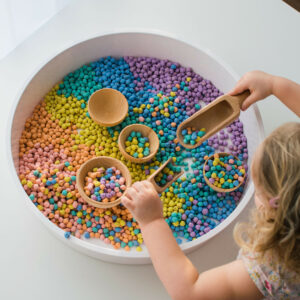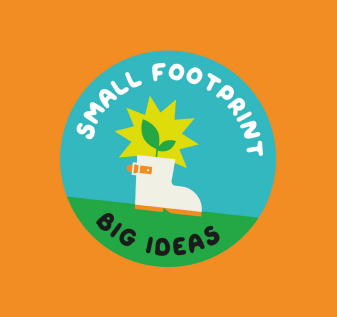6 top tips for imaginative, creative and curious play at home
Perhaps you’ve read our previous blog ‘what is open ended play’ or just want to elevate your at home play sessions, we’re here to help. We have complied a tried and tested list of our top tips for creating the conditions to help your child play creatively, independently and learn loads in the process. But before we give you the top tips I want to say well done to you – you are doing a great job already, simply by reading this blog you are making positive changes in your playful journey. Take it at your pace and try and enjoy it.
Our 6 top tips for great play
- There will probably be mess, that’s natural and normal, so make sure you choose a time and location which works for your. Setting up soil and water in a cream living room before you’re about to go out probably isn’t going to be the best conditions for a great open ended play session. It’s ok to choose a time and place that works for you.

- That sort of leads onto tip number two, try not to interfere. Once the little one is into the flow of playing take a step back, have a cup of tea (but do stay close, see point 3), read a book. By not offering suggestions of what might happen next, or adding new items into the play we let the child take the lead and follow their own thought processes. I have on occasion found myself sitting without saying anything for 15 minutes or so whilst my littlies are absorbed in their own worlds – it’s magic!
- Open ended play often works best when the child starts the play themselves, By this I mean, you may have set some bits up (perhaps playdough and loose parts, or cars and some planks of wood) but let the child find this invitation to play in their own time. I have rarely found a great open ended play session come about if I have suggested what my two could play with.


- Open ended play does not mean ‘alone play’. Children need us to be present during this play but not necessarily involved. Although if invited to join in go for it and enjoy but still let the child lead the play.
- Sometimes it doesn’t work and that is absolutely fine. We all have off days and children are no exception, maybe today they want a fixed goal (completing a puzzle for example). Or the invitation to play doesn’t spark their interest at the time. Try not to worry, move on and try again another day.
- Get outside. Simply by its nature the great outdoors offers so many open ended play opportunities, think forests (how many different things can the humble stick be), sand or your garden.


A few of our favourite toys and resources for open ended play
- Sand, soil , water

- Carboard boxes
- Cubes, bricks and balls
- bowls, containers (plant pots, plastic of wooden dishes, sorting trays)
- Small world items- trees, fences, sticks, vehicles
- Sensory dough and sensory bases
- Loose parts (wooden shapes, straws, leaves, flowers, bottle tops – the list is endless)
- Peg people and animals
- Real life objects – clean nappies, water spray bottles, teapots, old laptops, phone
Hopefully you are now bursting with ideas, a willingness to play and are ready to dive into the truly magic world of open ended play.
Do you ever find yourself sat on cold hard floor not really knowing the rules to some made up role play game?
If the answer is yes let me say well done, you are doing amazing things for your child’s imagination, creativity and play. You are helping to facilitate open ended play. And this is so wonderful because “unstructured, open ended play is where the magic of childhood happens” Alana Pace. Its for those precious moments when you catch a child totally absorbed in their play. And that is why all children need open ended play opportunities. This blog will guide you in what open ended play is and what the benefits of open ended play are
What is open ended play?
Open ended play is the most natural form of childhood play and is led by the child. Open ended play has no strict rules, no instructions and no desired outcomes. By removing these barriers children are free to discover, explore and learn in their own way and at their own pace. An overriding principle of open ended play is that its all about the process not the end result.
For example it’s putting some sensory dough, some wooden loose parts, sticks and leaves from the garden and letting your little one explore it for themselves, without any agenda as to what they ‘should’ create.
Or it could be setting up some different wooden shapes such as rings, cubes, hexagons and letting your little one explore or build or add to another play scene they have got going on. 
Ok, so what are the benefits of open ended play?

When a child is engrossed in open ended play they are in their most natural form of play and therefore most natural form of learning. We all know we learn things
more easily if we work out an issue or problem ourselves rather than simply being told the right answer.
So imagine you’re a child and a collections of different shaped blocks and balls have been la
id out with a ramp and you (by yourself) discover that the ball rolls down the ramp but the cube just slides or doesn’t move. Now you’re really curious so you start exploring the other objects around you, like a car or a stone or perhaps a peg doll. This play allows a little one to start investigating, making new neural pathways and sparking a curiosity in the world around them.
Other benefits to your little one include:
- Creating new neural pathways in their brain
- Nurturing their imagination and developing creativity and curiosity in the world around them
- Having a safe outlet for dealing with their emotions
- Gaining a sense of control
- Supporting their independence
- Building social confidence and communication skills
- Developing their vocabulary
- Learning how to solve real life problems
- Processing topics they find too hard to talk about
- Having fun on the child’s terms
So now your know what open ended play is and what the benefits are its time to start putting it all into practice.
How about starting really simply by putting some rice, oats or cereal, a bowl, a scoop or a spoon in a tray and letting your little one explore. Try not to interrupt the play and just let them go for it and see the magic of childhood, learning and play.








